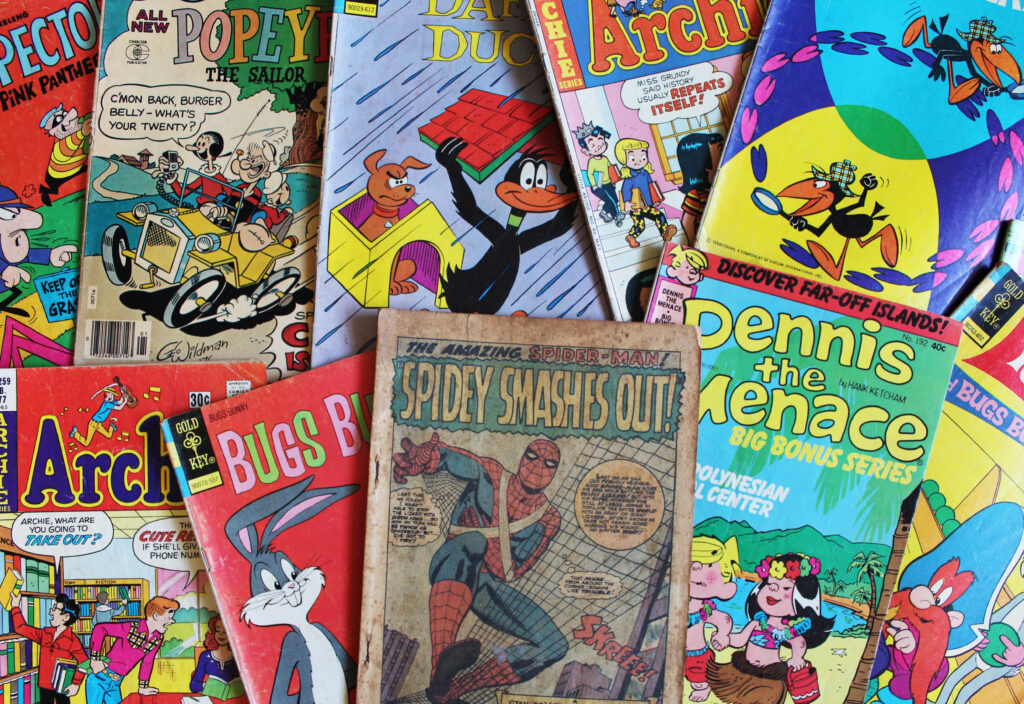Like clockwork, the newest iteration of technology, social media, is the subject of a moral panic that strongly echoes those of innovations past. Past panics have targeted comic books, television, and video games, creating lasting effects on the youth that should be a cautionary tale for the current moment. To be clear, social media has created unique risks for users that warrant additional protections and mitigation — evidenced by responsible platforms implementing robust content moderation policies and adhering to best practices such as those outlined by the Digital Trust & Safety Partnership. But these concerns should not give way to the re-introduction of overly restrictive legislation that, as discussed below, will harm all users and more importantly, those most vulnerable.
Past Panics

Comics
Between 1938 and the mid 1950s, widely considered the “golden age” of comic books, readers of all ages enjoyed the proliferation of creative works written by a wide range of authors, some of whom were from groups that were shut out of more respected fields of publishing. Comic books of all kinds flourished, benefiting readers with rich nuanced storylines that sometimes covered non-mainstream topics like race, religion, and gender. Others touched on the human fascination with horror, gore, and violence.
A prominent child psychologist began a crusade to link comic books to juvenile delinquency based on misinterpreted and misleading research that whipped the public into a frenzy. Comic books offered a scapegoat for underlying issues within society, and the media ran with the narrative. In 1954, the Senate held a 3-day hearing where critics used it as an opportunity to cite later-debunked research, recount lurid details of particular horror comics, and grill and discredit the comic book executives and psychologists defending the creative medium.
The comic book panic had devastating consequences for the comic book industry, and resulted in a flurry of legislation attempting to ban these books. Further, the looming risk of legislation that would outright ban or impose liability for particular contents pressured the industry to enact measures of self-regulation that would adhere to these unfounded concerns. The industry established the Comic Magazine Association of America which instituted the Comics Code Authority (CCA) that heavily censored the content of comics. Members submitted comics to the CCA, which screened them for adherence to its code, then authorized the use of their seal on the cover if the book was found to comply. The Comics Code included content requirements such as:
- Criminals should always be bad and never triumph over good — comic writing should make this narrative clear
- Authority figures (such as cops and government officials) should be respected
- Storylines must respect the sanctity of the family (e.g., no mentions of divorce, or gay characters); Batman needed to be “more heterosexual” — a love interest was introduced.
The Code also contained bans on comics dealing with racial and religious prejudice and granted the Code administrator the broad discretion to eliminate storylines on the basis that they “challenged” religious beliefs or other non-objective rationales. The content bans even extended to zombies, werewolves, vampires, and ghouls.
Ultimately, “[t]he comic book scare resulted in the censorship of minority identities in fiction, ruined the careers of authors and illustrators, and drove many young people away from the stories that spoke to them.” Over one hundred acts of legislation were introduced on the state and municipal levels to ban or limit the sale of comics. These threats to the First Amendment have received mixed treatment from the courts. In the 1959 case Katzev v. County of Los Angeles, California’s high court found the state’s ordinance banning the sale of crime comics unconstitutional, citing 1948 U.S. Supreme Court case Winters v. New York, which deems publications about bloodshed and crime as entitled to First Amendment protection, stating that the “distribution of such crime comic books is protected by state and federal constitutions”. The ordinance failed the “clear and present danger” test because there was no conclusive evidence of a causal connection between juvenile delinquency and the circulation of crime comic books. Despite some legal wins, the effects on the comic book industry were irreversible, and resulted in “the most brutal era of censorship arising from moral panic that American pop culture has ever known”. The Library of Congress has an excellent blog post discussing the history of the hearing and its outcomes.

Television
As TV quickly overtook radio as the most popular mode of mass communication throughout the 1950s and 60s, the question of violence on television was an issue raised almost immediately. When unprecedented social upheaval and violence erupted in the 1960s, often among high-school and college students, adults blamed television. Congress again held hearings in 1954, 1961, and 1964 whose tone is best summed up by the 1964 report stating, “The excessive amount of televised crime, violence and brutality can and does contribute to the development of attitudes in many young people that pave the way for delinquent behavior.”
In 1972, the United States Surgeon General released a report titled “Television and Growing Up: The Impact of Televised Violence.” The report ultimately found that “the accumulated evidence…does not warrant the conclusion that televised violence has a uniformly adverse effect nor the conclusion that it has an adverse effect on the majority of children.” Nor did it show that there was an increase in aggressive behavior in response to violent content. It did indicate that televised violence may lead to increased aggressive behavior in children who are highly aggressive to start with. However, the Surgeon General continued to use rhetoric framing television violence as a public health problem and the report was similarly portrayed by the media to support this assertion, even though the content of the report offered a much more complex picture.
A rise in crime in the 1990s renewed Congress and the media’s fervor in connecting the influence of violent television to the crime waves. There was a flurry of bills, some suggesting content-based restrictions like labeling, banning certain types of violent programming, or balancing violent programming with nonviolent. Other proposals adopted content-neutral regulations such as permitting only certain time-slots in which such programs could be shown outside of children’s viewing hours. Some of this legislation was successful, and some has been struck down on First Amendment grounds.

Video Games
As early as 1982, video games were under attack. The United States Surgeon General at the time, Dr. C. Everett Koop, proclaimed that video games were harmful to the health of young people who are “becoming addicted to the machines ‘body and soul’”, and suggested that video games were a leading cause of family violence. He also admitted that he had “no scientific evidence on the effect of video games on children” but predicted statistical evidence would come soon and support his assertions. For reference, he was talking about games such as Asteroids and Space Invaders.
This concern transformed into a panic in the 1990s after rhetoric around violent youth dominated the media, and the wildly popular game Mortal Kombat became available for home gaming systems. Senator Joe Lieberman became the face of a movement that insisted that these games “desensitized” young people, and “glor[ified] violence and [taught] children to enjoy inflicting the most gruesome forms of cruelty imaginable.” Senator Lieberman convened a hearing in which he played clips of Mortal Kombat and Night Trap, and threatened to form a commission to oversee video games. In response, the gaming industry attempted to self-regulate, forming the Entertainment Software Association (ESA) and creating a regulatory body called the Entertainment Software Ratings Board (ESRB), which would assign grades to games based on their content.
The subsequent years were marked by consistent efforts to connect video games to recent mass shootings by young people. In 1999, these efforts would face a tipping point following the Columbine shooting — after which it came out that the 2 teenage gunmen, both with histories of severe depression and issues with anger and rage, were avid players of the shooting game Doom, a first person shooter game. Congress held more hearings, and the public continued to blame TV and video game violence in part for the shooters’ horrific acts — after Columbine, “the number of published research articles examining violent video games increased nearly 300%.”
And yet, the evidence does not bear out the claims being made – there is little scientific data linking violent video games to acts of violence. The data, yet again, was overgeneralized, failing to recognize that the evidence more strongly suggests that people with already violent tendencies are perhaps more likely to be affected by violent video games. Despite the data, there was a consistent regulatory effort to ban the sale of violent video games until 2011, when, in Brown v. Entertainment Merchants Association, the Supreme Court struck down a California law on First Amendment grounds. The Court held that “like the protected books, plays, and movies that preceded them, video games communicate ideas–and even social messages–through many familiar literary devices…and through features distinctive to the medium… That suffices to confer First Amendment protection.”
Social Media

Social media is the most recent technology to dramatically shift the way that people consume content and media. From the emergence of March for Our Lives to social media blackouts, this medium has paved the way for powerful social change and movements. However, the way social media has been discussed in recent discourse mirrors, almost to a tee, that of “new” technologies of the past. While creating a safer online environment for children is an important goal and a shared desire, it should not give way to the reintroduction of regressive approaches that will have the same result — disproportionately harming vulnerable and marginalized people.
The Surgeon General’s 2023 Social Media and Youth Mental Health Report (“the Report”) is framed as if harm is a foregone conclusion, an assertion not supported by the evidence, which paints a much more complex picture. The misleading nature of the framing is exemplified by the following line: “Nearly every teenager in America uses social media, and yet we do not have enough evidence to conclude that it is sufficiently safe for them.” (p.11). This stands in contrast with the evidence put forth in a 2023 American Psychological Association Health Advisory on Social Media Use in Adolescence, which found that “using social media is not inherently beneficial or harmful to young people.” Reminiscent of the conclusions found regarding television and video game violence, the Surgeon General’s Report continues: “In most cases, the effects of social media are dependent on adolescents’ own personal and psychological characteristics and social circumstances…the effects of social media likely depend on what teens can do and see online, teens’ pre-existing strengths or vulnerabilities, and the contexts in which they grow up.” The Surgeon General’s choice to present the takeaway of the Report as he does, that social media cannot be conclusively found to be safe for all adolescents, incites and encourages panic that has harmful consequences.
The harmful consequences of the panic created around social media can impact vulnerable and marginalized youth the most profoundly, as was reflected particularly in the panics around comic books and video games. Comic books were a medium that many marginalized authors turned to when they could not break into more prestigious areas of publishing, and they produced storylines with a greater range of representation and more complex and nuanced story lines. When the Comics Code came into effect, the majority of these storylines were completely wiped away, and many of these authors lost their jobs and left the industry. During the video game panic, the youth who were most attracted to video games were often those who felt marginalized by mainstream society, many of whom experienced bullying; their only outlet faced vicious attacks that served to marginalize them even further.
This troubling pattern continues with the current panic around social media. The Surgeon General’s Report itself notes that social media has profoundly positive effects on LGBTQ and minority female youths in particular, “enabling peer connection, identity development and management, and social support.” Further, “a majority of adolescents report that social media helps them feel more accepted (58%), like they have people who can support them through tough times (67%), like they have a place to show their creative site (71%), and more connected to what’s going on in their friends’ lives (80%).” And yet, some of the measures and legislative proposals the Surgeon General’s Report suggests to mitigate the “harms” could jeopardize the safe spaces and important connections social media creates for these young people.
Some of the Surgeon General’s legislative suggestions and the further efforts to restrict social media could have negative effects both on children, as well as serve to threaten First Amendment rights. Aspects of certain age verification laws require parental consent — but when an LGBTQ teen, who has found a supportive community online, has not shared that part of their identity with their parents in fear of their safety, these laws could force these teens to make a very difficult choice and even put them in danger. Additionally, another risk posed by age-verification proposals is that they introduce unnecessary privacy and security risks, for users and platforms, by requiring covered entities to collect and store more sensitive information than required to avoid non-compliance. These are just some examples of the unintended but important consequences policymakers must consider with these efforts. But not all proposals have introduced such risks. Lawmakers in various states — such as New Jersey and North Carolina — have sought to create a safer online experience for all by empowering users, both parents and teens, through digital literacy and digital citizenship programs.
As discussed in the context of video games, these government hearings and reports “influence court decisions about what kinds of media can be censored or regulated. People have been sentenced to jail or gone free based on the testimony of video game scholars. And millions of dollars of taxpayer money has been spent fighting these battles, funding biased scientific studies that may do more harm than good.” This has applied to past reactionary panics, the one we are currently in the midst of, and likely again in the future.
Keeping kids offline is not the solution and neither is censoring free speech. Legislative efforts with that end in mind will only serve to harm some of the most vulnerable young people even further, and will undermine the positive change and direction these platforms continue to foster. Rather, lawmakers should pursue a whole-of-community approach to support those who are predisposed to experience harm from social media.
Credit:Source link




